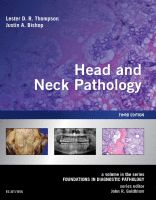Physical Address
304 North Cardinal St.
Dorchester Center, MA 02124

■ Squamous Cell Carcinoma (External Auditory Canal and Middle Ear) Squamous cell carcinoma (SCC) is a malignant tumor of squamous keratinocytes. Ultraviolet (UV) radiation is considered etiologic for external ear lesions, whereas chronic inflammation (otitis media) may be associated with…

▪ Ceruminous Adenoma Ceruminous adenoma is a benign glandular neoplasm of ceruminous glands (modified apocrine sweat glands) that arises solely from the external auditory canal (EAC). Clinical Features Ceruminous Adenoma—Disease Fact Sheet Definition ▪ Benign ceruminous gland neoplasm Incidence and…

▪ First Branchial Cleft Anomalies First branchial cleft anomalies include a spectrum of benign congenital fistulas, sinuses, and cysts and result from incomplete fusion of the first and second branchial arches, with persistence of the ventral component of the first…

■ Osteosarcoma Osteosarcoma (OS) is defined as a group of malignant tumors whose neoplastic cells produce bone. It is the most common primary malignant bone tumor. Aggressive behavior is usually associated with high-grade morphology of the atypical osteoid-producing osteoblasts. Tumors…

■ Ossifying Fibroma Ossifying fibroma is a benign neoplasm that falls in to the broader category of benign fibro-osseous lesions (BFOLs). All BFOLs are characterized by the replacement of native bone by fibrous and mineralized tissues and are grouped together…

■ Osteomyelitis Osteomyelitis (osteitis) is an inflammatory or infectious process in the marrow cavities of the bone. It may be either acute or chronic. There are many classification schemes, including composition of the infiltrate (acute, subacute, chronic, granulomatous), infectious agent…

■ Mucoepidermoid Carcinoma Clinical Features Mucoepidermoid carcinoma (MEC) is the most common malignant salivary gland tumor (12% to 29%). Over half of all cases involve major glands, particularly the parotid ( Fig. 13.1 ). Other sites include the mouth, particularly…

▪ Pleomorphic Adenoma Pleomorphic adenoma (PA), also called benign mixed tumor or mixed tumor, is a benign salivary gland neoplasm composed of ductal epithelial and myoepithelial cell proliferations set within a mesenchymal stroma. This tumor displays remarkable histomorphologic diversity, including…

■ Developmental Lesions, Including Heterotopia and Oncocytosis Salivary glands are composed of three paired major glands—the parotid, submandibular, and sublingual—and approximately 1000 minor seromucous glands that are distributed throughout the sinonasal tract, oral cavity, pharynx, larynx, and lower respiratory tract.…

▪ Squamous Cell Carcinoma Squamous cell carcinoma (SCC) arises not only from the surface epithelium of the oropharynx but also from the tonsillar crypts. It is steadily increasing in incidence due to high-risk human papillomavirus (HPV), and HPV-positive oropharyngeal SCC…